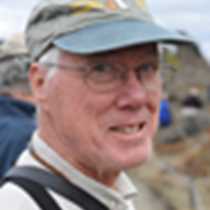Kirkenes, Norway
Anticipation rose as National Geographic Explorer neared the coast of Norway to complete our first crossing of the Barents Sea. It was shirt-sleeve weather on the bow of our ship as land came into sight in the mid-afternoon. We have come to Kirkenes (="church point or head") for fuel and provisions on our way to the Russian Arctic. As our crew was looking after the needs of the ship, we split into three groups to explore Kirkenes and surrounding countryside — one group to tour the city, another to visit Pasvik National Park with a natural history emphasis, and the third and largest group for a brief immersion into the Saami culture at Neidin. Kirkenes is surrounded by FennoScandian birch-pine forest, with a rich understory of berry-bearing plants. However, even at this latitude far above the Arctic Circle (about comparable to Prudhoe Bay, Alaska), much of the land is suitable for agriculture. Our motor coaches passed tidy Norwegian barns and fields with rolls of silage wrapped in white plastic, winter food for dairy cattle.
From the narration of our coach guide on the Natural History tour, it seems that three things dominate the psyche of the residents of Kirkenes: the lingering trauma of the German occupation during World War II; their close proximity to the Soviet Union (now, Russia); and consumption of hard drink during the long, dark northern winter. The Pasvik River, along which we drove, forms a border nearly 200km in extent. For much of our tour we could look across the valley at Russia. During the Soviet era, the border was tightly sealed. Now there is extensive trade and exchange, and the residents of Kirkenes are favorably inclined toward their neighbors because the role of the Soviet Union in forcing the German occupiers from Lapland in 1944. The departing army set torches to Lapland and virtually all buildings were burned. The memory of that terrible time fades slowly.
As we drove through the countryside, the thunder crashed, the lightning flashed, and a steady rain descended. Undeterred, we succeeded in finding ruffs, greenshanks, and golden plovers feeding in fields and fens. The birds are assembling into flocks and preparing for their coming fall migration. The Saami cultural tour stopped at a small, wooden, Russian Orthodox chapel dating from 1565 to view the religious icons within. It was nicely surrounded by a field of fireweed. At our destination, we were greeted by an extended family of Saami in their colorful dress. (We used to call them Laplanders, but they find the term insulting and it is no longer used.) We entered their tepee-like lavu, lit by an aromatic fire in the center. There, they served a traditional meal of reindeer stew with potatoes and lingonberries, followed by dessert of cloudberries with real cream. Then, they shared some Saami songs and dances. In Norway, only Saami people are allowed to own reindeer, and reindeer husbandry is a traditional way of life for many Saami, but now they do it with snow machines, motorcycles, and even helicopters. The 21st Century has come to Saamiland, but they cling tenaciously to their identity and their culture.




